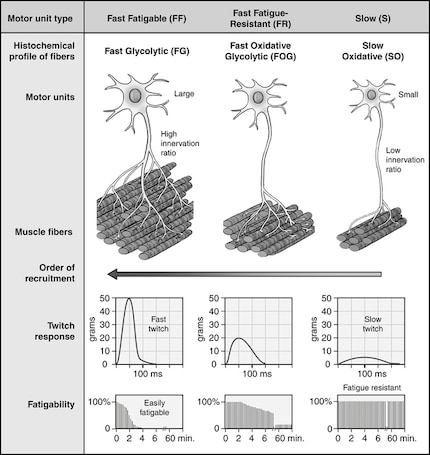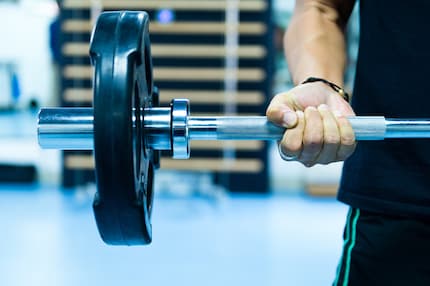
Background information
Go heavy or go home? How load and intensity influence muscle mass
by Claudio Viecelli

Ever been distracted during strength training? A thought that made your mind wander and forget which repetition you were on? Wouldn’t it be great if you could just ask your muscles which rep you’re on. Guess what? They’re not counting.
Muscles don’t have an internal counting mechanism. In other words, they don’t count repetitions. Instead, they evolved as an organ that stores and generates strength and allows us to interact with our environment.
So what exactly do we mean when we talk about reps? In strength training, a repetition is defined as a complete cycle of lifting and lowering a mass over a given range of motion. In physical terms, we’re talking about mechanical work (W = force × distance). The number of repetitions is one of the most commonly manipulated descriptors of strength training. The American College of Sports Medicine published several recommendations for strength training, recommending 8 to 12 repetitions to stimulate muscle growth [1,2]. The National Conditioning Strength Association recommends 6 to 12 repetitions for muscle growth and under 6 repetitions to increase strength [3]. To gain further understanding of this, we must first take a quick look at muscle physiology.
Muscles are activated by signals triggered in nerve cells in the brain. Through the spinal cord, these signals travel via motor neurons to the muscle fibres.
In science, the motor neuron and the muscle fibres innervated by that motor neuron are described as the motor unit. The motor unit is the smallest functional unit of the neuromuscular system. Based on twitch behaviour, fatigue and cell body size, motor units are divided into three types.

Recruit and fire! These two mechanisms regulate force production in the body. It depends both on the number of motor units recruited and on the firing frequency with which the action potentials are triggered in the motor neurons. The greater the recruitment and the faster the action potentials follow each other, the higher the muscle strength.
The motor units are recruited in order of size, the more muscle power is required [5,6]. This means that type S motor units are recruited first, followed by FR and then FF-type units in an additive manner. This generates a maximum arbitrary peak force (see graph).
Strength training is tiring. Muscle fatigue is a complex physiological problem. As fatigue increases, additional motor units are recruited to maintain external torque. Physically speaking, torque is defined as a measure of how much a force acting on an object causes that object to rotate. So if you’re doing a biceps exercise with a dumbbell, the dumbbell represents the external torque. Thereby, he muscles generate an internal, muscular torque to counteract the external torque. In the process, the internal, muscular torque, decreases from repetition to repetition due to fatigue.
Once all motor units have been recruited, you can still move the dumbbells as long as the internal, muscular torque is greater than the external torque. In other words, recruiting all motor units doesn’t necessarily require a high training load. You can also achieve full recruitment with low training loads, provided you train up to muscle failure.

The force contribution and fatigue resistance are different in all the motor units. FF-type motor units produce the greatest force. However, they also fatigue very quickly (the force drop is approx. 80 to 90% after 1 to 2 min.) (see graph). Once all motor units are recruited, the torque that can be generated internally by muscles depends on the fatigue of the motor units. This fatigue occurs in FF-type motor units after about two minutes already. This leads to the inevitable termination of the exercise because the internal, muscular torque is less than the external torque.
Two studies show the importance of the repetition factor for strength training. in once of them, the factor is related to the intensity and in the other one, to the stress duration:
A research group around Kumar et al. [7] investigated the relationship between muscular protein buildup and exercise intensity using a study design in which the work done was equal in two test groups. Strength training consisted of dominant leg extension exercises from 20% to 90% 1-RM in 25 young (24 ± 6 years) and older (70 ± 5 years) men with identical body mass indexes (24 ±). In order to average their workouts, participants were divided into groups:
Workouts were done with a two-minute break between each set. Protein build-up was measured 1, 2, and 4 hours after exercise. Kumar and colleagues found that intensity and protein build-up were related to each other in a [sigmoid function (a model for describing growth processes, which looks like an S. Hence why it’s also called an S-function). Intensities greater than 60% 1-RM didn’t result in any further significant increase in protein breakdown. This means that increasing the intensity of your training doesn’t further increase protein buildup and thus muscle growth. What’s striking is that the effort is the same, but the number of repetitions is different.
20% 1-RM x 3 x 27= 16.2
90% 1-RM x 6 x 3 = 16.2
The researchers around Burd et al. [8] investigated the question what influence the stress duration per repetition has on the protein build-up. For this purpose, young men trained one leg at a time with a knee extension exercise with 30% of the 1-RM until muscle failure. To do this, they each completed 3 sets with 2 minutes of rest in between. In addition, the researchers specified the time for one repetition.
The participants trained at 6 seconds per movement phase (concentric and eccentric), so 12 seconds for each repetition. With the same number of repetitions, the participants now trained the other leg, but with a movement speed of 2 seconds per repetition. The number of repetitions was 12 ± 1, 7 ± 1, and 6 ± 1 for sets 1, 2, and 3, respectively, for both legs. Over the following 30 hours, the researchers then examined protein build-up as an indicator of muscle growth.
In which group was the protein build-up higher? Here’s a quick recap: The same external mechanical effort was put in. The only difference was the stress duration of approximately 407 ± 23 seconds compared to 50 ± 3 seconds for the different movement paces. 24 to 30 hours after exercise, protein build-up was approximately 40% higher for the slow condition than for the fast condition. This means, tension duration has a significant effect on muscle anabolism. This is because of the stress duration, or the maximisation of the area of the tension-time integral, has a direct effect on a protein (JNK in our body. it inhibits protein degradation. Thus, if less protein is degraded than built up, there is a net positive balance [9,10].
What can we take away from these two studies? As already described in detail, muscle growth is already stimulated by 60% of 1-RM. Increasing the intensity does not bring any additional effect. In this regard, we also see that in the study design used, the mechanical effort was the same, but the number of repetitions varied.
However, tension duration appears to have a significant effect on muscle growth for the same external effort. Through the mechanism of fatigue, we can recruit all motor units and expose them to mechanical and metabolic stress for as long as possible until they are completely exhausted and the exercise has to be stopped. Based on the physiological properties mentioned above, this is the case at approximately 120 seconds for FF-type motor units. So the goal should be maximising the area of the recruitment-time integral. In other words: The time you put mechanical effort in at full recruitment.
The concept of specifying a number of repetitions actually has the same intent, but fails in different scenarios.
Complete fatigue of high-threshold motor units (FF and FR) stimulates protein build-up and the muscle growth very sturdily. This means you should opt for a slow pace of execution so that the muscles are constantly exposed to a high muscular tension. Then try to maintain this tension for as long as possible. Choose the load so that you can keep up the exercise for about 120 seconds. Keep in mind that muscles don’t count reps.

Images: Shutterstock"
Molecular and Muscular Biologist. Researcher at ETH Zurich. Strength athlete.
Interesting facts about products, behind-the-scenes looks at manufacturers and deep-dives on interesting people.
Show all
Background information
by Claudio Viecelli

Background information
by Claudio Viecelli

Background information
by Claudio Viecelli